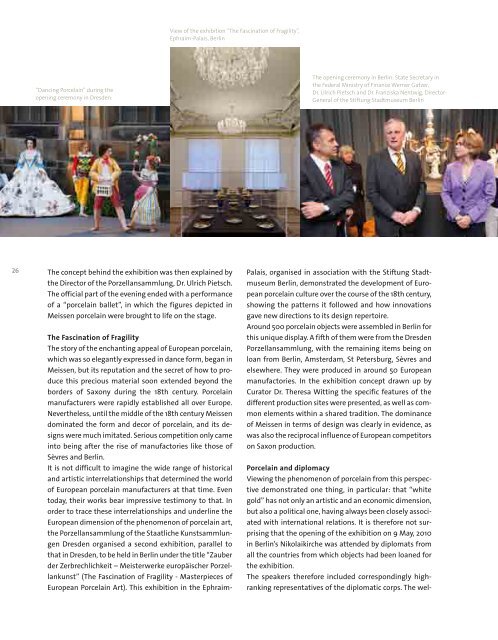Annual Report 2010 - Staatliche Kunstsammlungen Dresden
Annual Report 2010 - Staatliche Kunstsammlungen Dresden
Annual Report 2010 - Staatliche Kunstsammlungen Dresden
Create successful ePaper yourself
Turn your PDF publications into a flip-book with our unique Google optimized e-Paper software.
26<br />
“Dancing Porcelain” during the<br />
opening ceremony in <strong>Dresden</strong><br />
View of the exhibition “The Fascination of Fragility”,<br />
Ephraim-Palais, Berlin<br />
The concept behind the exhibition was then explained by<br />
the Director of the Porzellansammlung, Dr. Ulrich Pietsch.<br />
The official part of the evening ended with a performance<br />
of a “porcelain ballet”, in which the figures depicted in<br />
Meissen porcelain were brought to life on the stage.<br />
the Fascination of Fragility<br />
The story of the enchanting appeal of European porcelain,<br />
which was so elegantly expressed in dance form, began in<br />
Meissen, but its reputation and the secret of how to produce<br />
this precious material soon extended beyond the<br />
borders of Saxony during the 18th century. Porcelain<br />
manufacturers were rapidly established all over Europe.<br />
Nevertheless, until the middle of the 18th century Meissen<br />
dominated the form and decor of porcelain, and its designs<br />
were much imitated. Serious competition only came<br />
into being after the rise of manufactories like those of<br />
Sèvres and Berlin.<br />
It is not difficult to imagine the wide range of historical<br />
and artistic interrelationships that determined the world<br />
of European porcelain manufacturers at that time. Even<br />
today, their works bear impressive testimony to that. In<br />
order to trace these interrelationships and underline the<br />
European dimension of the phenomenon of porcelain art,<br />
the Porzellansammlung of the <strong>Staatliche</strong> <strong>Kunstsammlungen</strong><br />
<strong>Dresden</strong> organised a second exhibition, parallel to<br />
that in <strong>Dresden</strong>, to be held in Berlin under the title “Zauber<br />
der Zerbrechlichkeit – Meisterwerke europäischer Porzellankunst”<br />
(The Fascination of Fragility Masterpieces of<br />
European Porcelain Art). This exhibition in the Ephraim<br />
The opening ceremony in Berlin: state secretary in<br />
the Federal Ministry of Finance Werner Gatzer,<br />
Dr. Ulrich Pietsch and Dr. Franziska Nentwig, Director-<br />
General of the stiftung stadtmuseum Berlin<br />
Palais, organised in association with the Stiftung Stadtmuseum<br />
Berlin, demonstrated the development of European<br />
porcelain culture over the course of the 18th century,<br />
showing the patterns it followed and how innovations<br />
gave new directions to its design repertoire.<br />
Around 500 porcelain objects were assembled in Berlin for<br />
this unique display. A fifth of them were from the <strong>Dresden</strong><br />
Porzellansammlung, with the remaining items being on<br />
loan from Berlin, Amsterdam, St Petersburg, Sèvres and<br />
elsewhere. They were produced in around 50 European<br />
manufactories. In the exhibition concept drawn up by<br />
Curator Dr. Theresa Witting the specific features of the<br />
different production sites were presented, as well as common<br />
elements within a shared tradition. The dominance<br />
of Meissen in terms of design was clearly in evidence, as<br />
was also the reciprocal influence of European competitors<br />
on Saxon production.<br />
porcelain and diplomacy<br />
Viewing the phenomenon of porcelain from this perspective<br />
demonstrated one thing, in particular: that “white<br />
gold” has not only an artistic and an economic dimension,<br />
but also a political one, having always been closely associated<br />
with international relations. It is therefore not surprising<br />
that the opening of the exhibition on 9 May, <strong>2010</strong><br />
in Berlin’s Nikolaikirche was attended by diplomats from<br />
all the countries from which objects had been loaned for<br />
the exhibition.<br />
The speakers therefore included correspondingly highranking<br />
representatives of the diplomatic corps. The wel

















